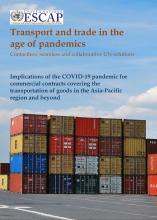
Implications of the COVID-19 pandemic for commercial contracts covering the transportation of goods in the Asia-Pacific region and beyond
With a view to increase awareness of Government officials and transport operators in Asia and the Pacific region on the ways of addressing some of the key legal implications of COVID-19 for commercial contracts covering transport of goods and to assist shippers and consignees, particularly in developing countries in addressing some of the key commercial law implications of the COVID-19 crisis, the UNESCAP secretariat conducted research and preliminary analysis of the challenges arising from the COVID-19 crisis affecting international commercial contracts, including contracts on international carriage of goods by various modes of transport, focusing particularly on land and multimodal transport.
ITF Southeast Asia Transport Outlook
This report provides scenarios for future transport demand and CO2 emissions in Southeast Asia up to 2050 to help decision-makers chart pathways to sustainable, resilient transport. The scenarios reflect existing policy initiatives and specific constraints in the region. They also examine the potential impact of policies addressing the challenges and opportunities for transport from Covid-19.
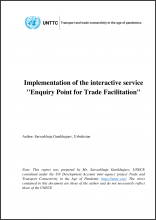
Uzbekistan: Implementation of the interactive service «Enquiry Point for Trade Facilitation»
Article 1 of the TFA obliges WTO members (and therefore all interested parties) to promptly publish information related to international trade, so that WTO members (and, accordingly, all interested parties) can familiarize themselves with the rules to ensure a transparent and predictable environment for international trade. WTO Members are encouraged to provide access to trade-related information via Internet and establish or maintain enquiry points (EP).
Currently, in the Republic of Uzbekistan, work is underway to bring national legislation in line with the requirements of the WTO Trade Facilitation Agreement (TFA).
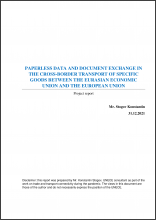
Paperless Data and Document Exchange in the Cross-Border Transport of Specific Goods between the Eurasian Economic Union and the European Union
In the context of the recovery from the COVID-19 pandemic and the general direction of building back better this project aims to develop and practically test paperless data and document exchange in the cross-border transport of specific goods between the Eurasian Economic Union and the European Union.
Focusing on a specific pilot case of multimodal delivery of goods author of this study conducted research and offered practical recommendations how to align used by different participants in the supply chain in their IT systems to the UN/CEFACT standards and Multimodal Transport Reference Data Model, allowing for a seamless exchange of electronic data and documents (B2B exchange), as well as developing electronic B2G documents for submission to regulatory authorities.
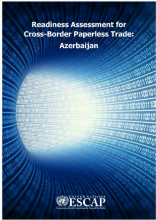
Readiness Assessment for Cross-Border Paperless Trade: Azerbaijan
This report provides an assessment of the Republic of Azerbaijan’s readiness for cross-border paperless trade, i.e., the conduct of international trade on the basis of electronic data and documents. Following a brief review of the state of play in trade facilitation implementation in the Republic of Azerbaijan, findings from the technical and legal readiness assessments for cross-border paperless trade are presented. Recommendations on both technical and legal aspects of cross-border paperless trade are then provided, followed by an initial action plan for the Republic of Azerbaijan to move forward.
The complete set of Cross-Border Paperless Trade Readiness Assessment reports can be accessed here.
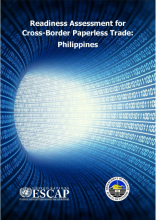
Readiness Assessment for Cross-Border Paperless Trade: Philippines
This report provides an assessment of the Philippines’ readiness for cross-border paperless trade, i.e., the conduct of international trade based on electronic data and documents.
A team of experts conducted this assessment following readiness checklists developed by the ESCAP Interim Intergovernmental Steering Group on Cross-Border Paperless Trade Facilitation, of which the Philippines is a member. National consultation on facilitating cross-border paperless trade was co-organized by the Philippine Bureau of Customs (BOC) and ESCAP on 8 March 2021, when preliminary findings from the visits and interviews were further reviewed, consolidated and validated.
The report is co-published by ESCAP and the Philippine Bureau of Customs (BOC).
The complete set of Cross-Border Paperless Trade Readiness Assessment reports can be accessed here.
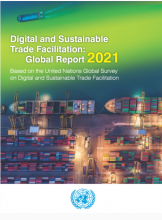
Digital and Sustainable Trade Facilitation: Global Report 2021
This report reviews the progress of trade facilitation reforms across 144 countries, based on the fourth UN Global Survey on Digital and Sustainable Trade Facilitation. The analysis is based on 58 trade facilitation measures that are classified into four groups (General Trade Facilitation, Digital Trade Facilitation, Sustainable Trade Facilitation and Other Trade Facilitation) covering both binding and non-binding WTO TFA measures, as well as measures beyond the scope of WTO TFA. The report aims at enabling countries and development partners to take a forward-looking approach to trade facilitation, better understand and monitor progress, support evidence-based public policies, share best practices, and identify emerging capacity-building and technical assistance needs.
For more information on the UN Global Survey on Digital and Sustainable Trade Facilitation and other reports, please visit untfsurvey.org
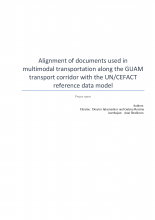
Alignment of documents used in multimodal transportation along the GUAM transport corridor with the UN/CEFACT reference data model
The objective of this project is further development of the digital transport documents that could provide seamless information flows accompanying cargo flows between countries along the GUAM transport corridor. Due to its position in the middle of the cargo transport routes between Europe and Asia, the use of UN/CEFACT standards and recommendations for cargo information sharing along this route makes much sense.
The focus of the project is on the practical application of the data models and standards to facilitate real-world transport operations that take place along this transport route. This is achieved by creating digital twins of real business documents that are mapped to the UN/CEFACT multimodal transport reference data model (MMT RDM) to ensure interoperability both in terms of changing jurisdictions and modes of transport along the route.
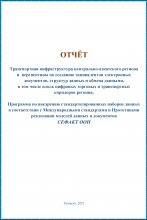
CA Transport Infrastructure and Perspectives on Development of Electronic Document Equivalents, Data Structures and Data Exchange
This Report serves as a preparation to the research of trade and transport corridors going though the Central Asia and establishes the necessity of digitalization of multimodal transport data as well as exchange of documents along those corridors through the use of UN & UN/CEFACT standards.
This Project is the joint initiative of the UNECE and the Ministry of Transport of the Republic of Uzbekistan.
The relevance of this project is the current common interest of all the countries in the region to jointly develop the transport links.
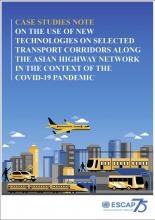
Seamless and smart connectivity along the Asian Highway network in the time of COVID-19
Freight transport operations poses the risks during the pandemics, especially if it is not fully computerized. As documents and goods continue to be subjected to physical checks for customs and other regulatory purposes, crew members and staff at border-crossing points and control terminals are exposed to the risk of contagion by the nature of their work. in this context, the use of information and communication technologies (ICT) and intelligent transport systems (ITS) is directly relevant to the pandemic response and recovery policies.Optimization of automation and digitalization can reduce the need for human interaction, making cross-borders transport safer and more resilient to disruptions. In this context, this technical note aims to offer policy recommendations for policy responses using new technologies and smart road solutions to preserve the regional transport connectivity in the time of the pandemics and other similar disruptions.